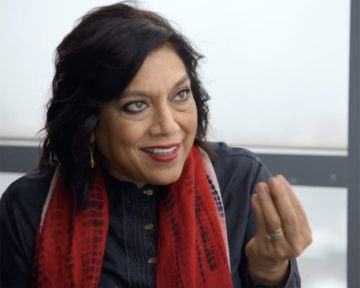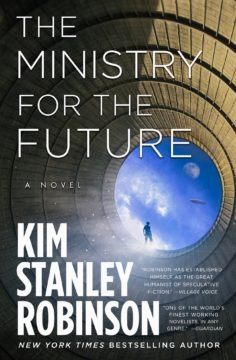Isaac Chotiner in The New Yorker:
 This month marks the American release of the director Mira Nair’s six-part television adaptation of “A Suitable Boy,” Vikram Seth’s beloved, kaleidoscopic novel of early post-Partition India, from 1993. (It began streaming on Acorn TV on December 7th.) The book, which, at more than thirteen hundred pages, is longer than “War and Peace,” tells the story of a young woman, Lata, and her search for a husband, while also featuring a remarkable cast of characters, largely from four interwoven families. The novel also touches on land reform, cricket, and religious tension, in playful, inventive language and sometimes with laugh-out-loud humor. Seth reportedly has been working on a sequel for more than a decade, the rumors of which have thrilled his fans.
This month marks the American release of the director Mira Nair’s six-part television adaptation of “A Suitable Boy,” Vikram Seth’s beloved, kaleidoscopic novel of early post-Partition India, from 1993. (It began streaming on Acorn TV on December 7th.) The book, which, at more than thirteen hundred pages, is longer than “War and Peace,” tells the story of a young woman, Lata, and her search for a husband, while also featuring a remarkable cast of characters, largely from four interwoven families. The novel also touches on land reform, cricket, and religious tension, in playful, inventive language and sometimes with laugh-out-loud humor. Seth reportedly has been working on a sequel for more than a decade, the rumors of which have thrilled his fans.
Nair, who was born in 1957 in the Indian state of Odisha (then called Orissa), and has been based in New York for about four decades, was an obvious choice for the adaptation. In 1988, she directed “Salaam Bombay!,” a critically acclaimed account of life in the slums of Mumbai. She followed it up with an early Denzel Washington drama, “Mississippi Masala,” about an Indian from Uganda in the American South. Since then, Nair has made ten feature films, including “Monsoon Wedding,” from 2001, and has become known as one of the preëminent interpreters of the Indian-immigrant experience. Nair has also adapted classic novels, including “Vanity Fair,” and several pieces of modern literature, such as Jhumpa Lahiri’s “The Namesake” and Mohsin Hamid’s “The Reluctant Fundamentalist.” In a Profile of Nair, in 2002, John Lahr wrote, “Nair’s films negotiate disparate ethnic geographies with the same kind of sly civility she practices in life. Her approach is sometimes oblique: she doesn’t make political films, but she does make her films politically. Her gift, to which ‘Monsoon Wedding’ attests, is to make diversity irresistible.”
Nair and I recently spoke over Zoom, while she was completing work on the last episode of the series. During our conversation, which has been edited for length and clarity, we discussed her career as a filmmaker, the challenges of adapting an epic novel, and how rising intolerance in India, led by the Hindu-nationalist Bharatiya Janata Party, affected her work on “A Suitable Boy.” After our interview, it was reported that members of the B.J.P. called for an investigation of Netflix, the series’ Indian distributor, claiming that the depiction of a kiss between a Muslim man and Hindu woman intentionally affronts religious sentiments, which in India is a criminal offense. Netflix has made no public comment, and Nair declined to address the complaint.
More here.

 In her job as a physician at the Boston Medical Center in Massachusetts, Sondra Crosby treated some of the first people in her region to get COVID-19. So when she began feeling sick in April, Crosby wasn’t surprised to learn that she, too, had been infected. At first, her symptoms felt like those of a bad cold, but by the next day, she was too sick to get out of bed. She struggled to eat and depended on her husband to bring her sports drinks and fever-reducing medicine. Then she lost track of time completely.
In her job as a physician at the Boston Medical Center in Massachusetts, Sondra Crosby treated some of the first people in her region to get COVID-19. So when she began feeling sick in April, Crosby wasn’t surprised to learn that she, too, had been infected. At first, her symptoms felt like those of a bad cold, but by the next day, she was too sick to get out of bed. She struggled to eat and depended on her husband to bring her sports drinks and fever-reducing medicine. Then she lost track of time completely. My Jewish maternal grandparents came to America just ahead of WWII. Nearly all of my grandmother’s extended family were wiped out in the Holocaust. Much of my grandfather’s extended family had previously emigrated to Palestine.
My Jewish maternal grandparents came to America just ahead of WWII. Nearly all of my grandmother’s extended family were wiped out in the Holocaust. Much of my grandfather’s extended family had previously emigrated to Palestine.

 shocking. Torcetrapib, for example, failed at the very end of its phase III trial. So many resources had been expended to get that far in development. Everything spent was lost. All that remained was a big data pile worth virtually nothing, along with pilot plants that were built to supply the drug to thousands of patients across years of clinical trials.
shocking. Torcetrapib, for example, failed at the very end of its phase III trial. So many resources had been expended to get that far in development. Everything spent was lost. All that remained was a big data pile worth virtually nothing, along with pilot plants that were built to supply the drug to thousands of patients across years of clinical trials.
 “The American way of life is not up for negotiation.” —George HW Bush to the assembled international diplomats at the Earth Summit in Rio de Janeiro, 1992
“The American way of life is not up for negotiation.” —George HW Bush to the assembled international diplomats at the Earth Summit in Rio de Janeiro, 1992 Not since the Civil War and Reconstruction has the citizenry in the United States been so divided. In our current
Not since the Civil War and Reconstruction has the citizenry in the United States been so divided. In our current 
 November 6, 1860. Perhaps the worst day in James Buchanan’s political life. His fears, his sympathies and antipathies, the judgment of the public upon an entire career, all converge into a horrible realty. Abraham Lincoln, of the “Black Republican Party,” has been elected President of the United States.
November 6, 1860. Perhaps the worst day in James Buchanan’s political life. His fears, his sympathies and antipathies, the judgment of the public upon an entire career, all converge into a horrible realty. Abraham Lincoln, of the “Black Republican Party,” has been elected President of the United States. 

 Back in 1971, I couldn’t have predicted that the release of Joni Mitchell’s fourth album, Blue, would mark the beginning of the end of a friendship.
Back in 1971, I couldn’t have predicted that the release of Joni Mitchell’s fourth album, Blue, would mark the beginning of the end of a friendship.
 2020 has been a wild ride, but it’s almost over, and I’m here to tell you it wasn’t all bad, as some great music came out this year – so much, in fact, that we’ll have to have two or even three podcasts this time even for the small taste which is our annual year-end review. Here’s part 1 (widget and link below).
2020 has been a wild ride, but it’s almost over, and I’m here to tell you it wasn’t all bad, as some great music came out this year – so much, in fact, that we’ll have to have two or even three podcasts this time even for the small taste which is our annual year-end review. Here’s part 1 (widget and link below). Beth, the protagonist of the TV show The Queen’s Gambit, is not someone you’d want as a friend. She takes money from her childhood mentor—the old janitor who taught her chess—and never pays him back, visits him or thanks him for launching her career. She treats the young men who help her improve—a group that eventually coalesces into a supportive entourage—in a similarly instrumental way. She is so focused on winning tournaments that she can barely spare a word of caution when her adoptive mother is falling into a fatal alcoholic spiral. When she loses, she is petulant and childish, unlike her opponents, who are graceful and kind. She is cruel and manipulative when—as an adult—she plays against a talented Russian child, softening to him only after she has beaten him.
Beth, the protagonist of the TV show The Queen’s Gambit, is not someone you’d want as a friend. She takes money from her childhood mentor—the old janitor who taught her chess—and never pays him back, visits him or thanks him for launching her career. She treats the young men who help her improve—a group that eventually coalesces into a supportive entourage—in a similarly instrumental way. She is so focused on winning tournaments that she can barely spare a word of caution when her adoptive mother is falling into a fatal alcoholic spiral. When she loses, she is petulant and childish, unlike her opponents, who are graceful and kind. She is cruel and manipulative when—as an adult—she plays against a talented Russian child, softening to him only after she has beaten him. The idea that the Earth itself is like a single evolving ‘organism’ was developed in the mid-1970s by the independent English scientist and inventor James Lovelock and the American biologist Lynn Margulis. They dubbed it the ‘Gaia hypothesis’, asserting that the biosphere is an ‘active adaptive control system able to maintain the Earth in homeostasis’. Sometimes they went pretty far with this line of reasoning: Lovelock even ventured that algal mats have evolved so as to control global temperature, while Australia’s Great Barrier Reef might be a ‘partly finished project for an evaporation lagoon’, whose purpose was to control oceanic salinity.
The idea that the Earth itself is like a single evolving ‘organism’ was developed in the mid-1970s by the independent English scientist and inventor James Lovelock and the American biologist Lynn Margulis. They dubbed it the ‘Gaia hypothesis’, asserting that the biosphere is an ‘active adaptive control system able to maintain the Earth in homeostasis’. Sometimes they went pretty far with this line of reasoning: Lovelock even ventured that algal mats have evolved so as to control global temperature, while Australia’s Great Barrier Reef might be a ‘partly finished project for an evaporation lagoon’, whose purpose was to control oceanic salinity.